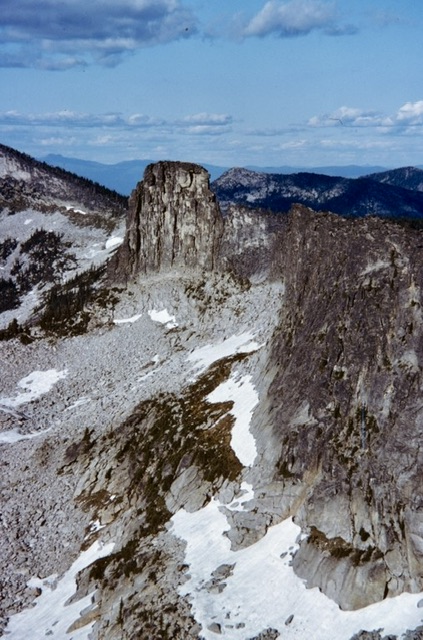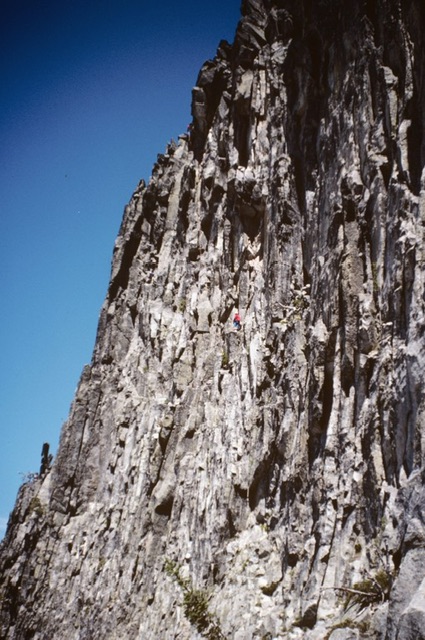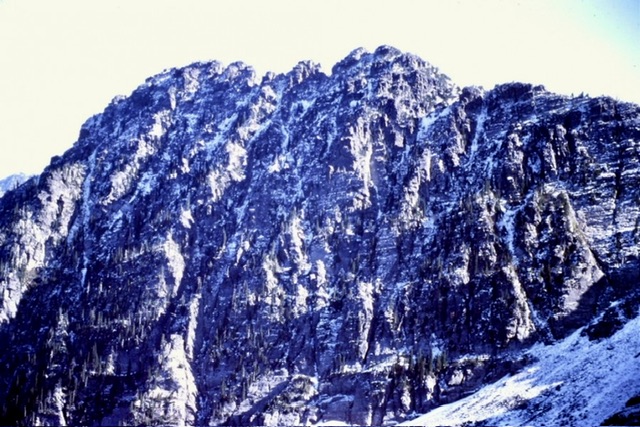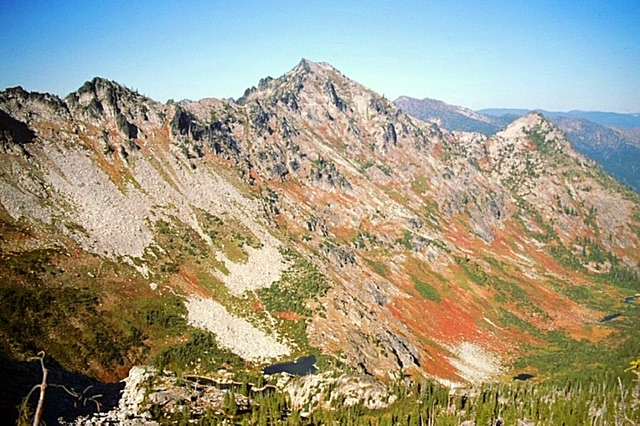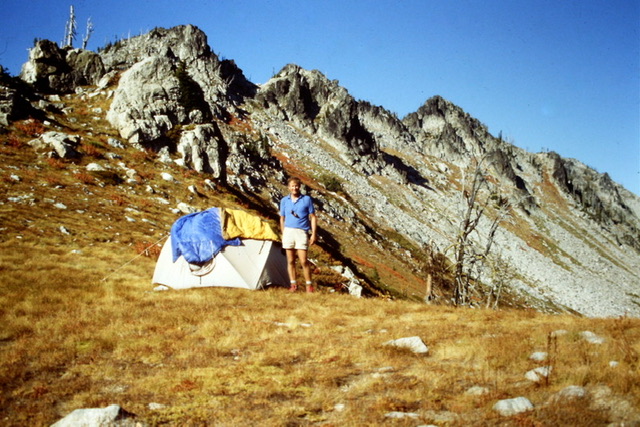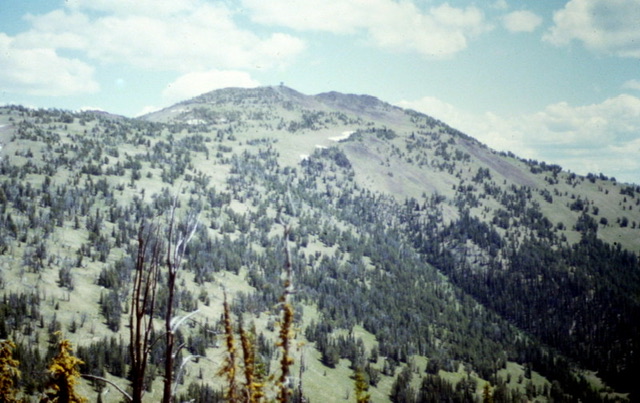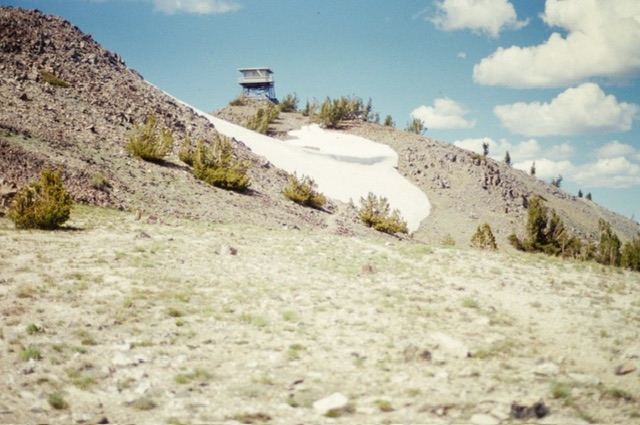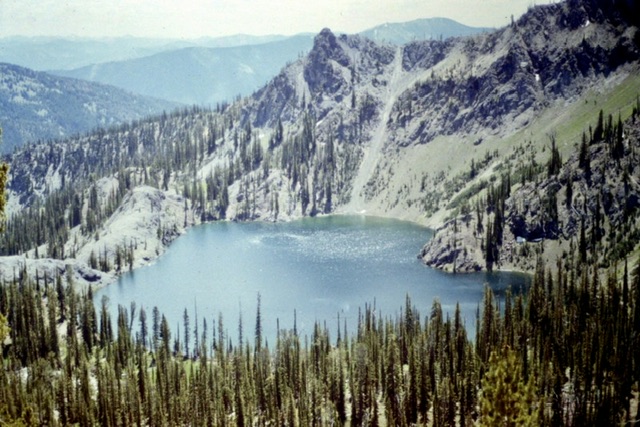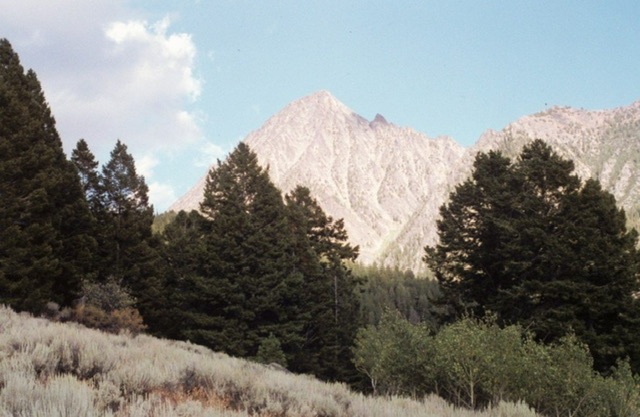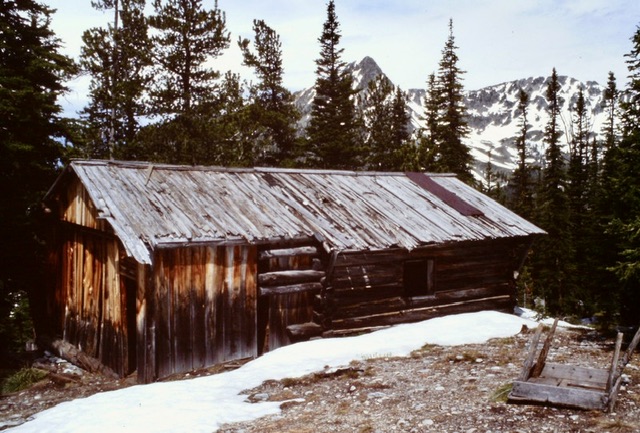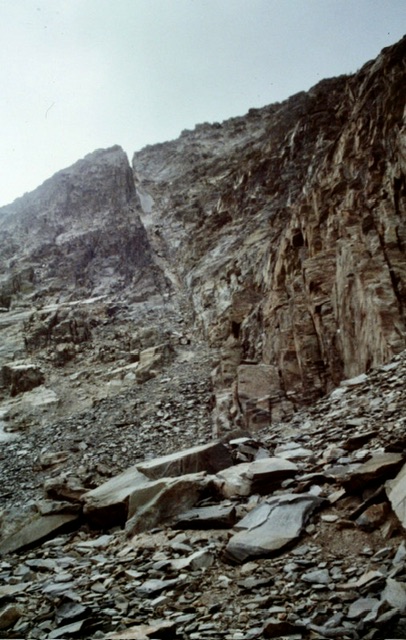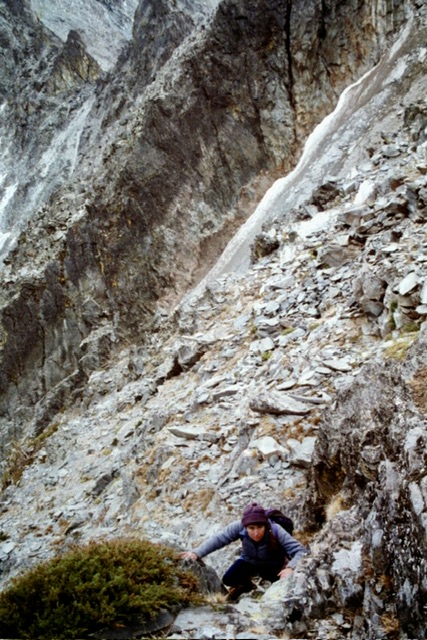ARTICLE INDEX
This Article was first published in the March issue of Idaho Magazine, Vol. 23, No. 6
There are many reasons to climb a mountain. There is the challenge, and we wonder if we will measure up. There is the lure of exploring the mountain’s wild, remote, and possibly unexplored terrain. We ask, “Has anyone climbed that peak?” There is the promise of stunning vistas from the summit. We wonder about, and long to discover, what might be found up there. And there is the inexplicable inspiration that an attractive mountain plants in our minds. Its shape, height, or remote location might create the desire to unlock its secrets. Perhaps all these factors combined will create a sense of foreboding or mystery that somehow overwhelms our better judgment and draws us upward.
—Tom Lopez, “Bell Mountain Calling,” IDAHO magazine, March 2021.
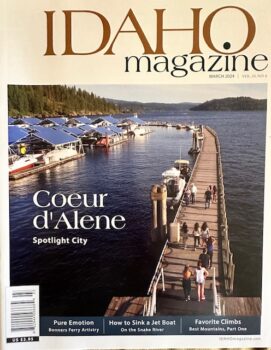 If you’ve read “Bell Mountain Calling,” then you already can guess that number one on the list of my twenty-five favorite Idaho climbs is Bell Mountain. The following five climbs are curated from that list, but the numeric order in their ranking didn’t figure in my choice. Instead, I based it partly on the stories I have to tell about each climb and partly to present a geographic order that goes from north to south. This month I start atthe top of the state and go down through the northern half, while next month I’ll look at five peaks in the state’s southern half, from top to bottom. My intent with this approach is to highlight the diversity of Idaho’s mountains.
If you’ve read “Bell Mountain Calling,” then you already can guess that number one on the list of my twenty-five favorite Idaho climbs is Bell Mountain. The following five climbs are curated from that list, but the numeric order in their ranking didn’t figure in my choice. Instead, I based it partly on the stories I have to tell about each climb and partly to present a geographic order that goes from north to south. This month I start atthe top of the state and go down through the northern half, while next month I’ll look at five peaks in the state’s southern half, from top to bottom. My intent with this approach is to highlight the diversity of Idaho’s mountains.
Chimney Rock, Selkirk Mountains
Way back in 1984, when I was living in Moscow, I visited a Spokane climbing equipment shop. Staring me in the face was a spectacular photo of Chimney Rock, often referred to as the “Lightning Rod” of northern Idaho, which long has enticed climbers to attempt its vertical walls. It looked challenging. I managed to track down a copy of Off Belay Magazine, which was the climbing magazine of its day. The copy contained an article by Ron Klimkow that gave an extensive discussion of Chimney Rock, its geology,and its climbing history. One route, the first ascent in 1934, appeared to be a reasonable test of my then-moderate technical climbing skills.
On July 22 of that year, Dana Hanson and I drove north to Priest Lake and then up a rutted, brushy road to the base of Mount Roothan. We found a nice campsite on Roothan’s west ridge and early the next morning we dropped off the ridge totraverse along the base of the Selkirk Mountains’ crest to the base of Chimney Rock. We were surprised to find other climbers had already started up the west face, which was the most popular route. Nearby, other climbers were attempting more adventurous routes. It was a Saturday and a party-like atmosphere prevailed.
We put on our climbing harnesses, I set a belay, and Dana started up the route,which angled to our left. She reached the end of the first pitch and I followed. It is an exposed route but the holds were large and easy to find. When I got up to her spot, I found her talking with a cheerful climber from the team ahead of us. He turned out to beJim States of Spokane, who a year earlier had summited Mount Everest via one of the most difficult routes climbed to date on that giant. We spoke to him as he belayed a friend up Chimney Rock. When his climbing partner yelled, “Climb,” he nonchalantly climbed away from us, without a hint of concern about the precarious nature of the place we shared on the wall.
Dana and I eventually made our way up the second pitch and then to the summit,where the full glory of the Selkirks came into view. The range, which is up to thirty miles wide, surrounds the Priest Lake Basin. The Idaho Selkirk Mountains are a complex range with significant valley-to-summit elevation gains, rugged canyons, and deep forests. The peaks are formed of granite from the Kaniksu Batholith and Spokane Dome, as well as Precambrian rocks. The name “Kaniksu Range” is sometimes used to identify the mountains west of the Priest Lakes. The central crest is sometimes known as the Priest Range. This geologic stew, along with Pleistocene glaciations, carved the Selkirks into the rugged and scenic terrain that now stretched out in front of us. Rank: 18.
Scotchman Peak, Cabinet Mountains
In 1984, I was busy and stressed by my law school studies and could not think of a better salve than climbing a mountain. On September 29, Dana and I made a predawn drive north to the trailhead of Scotsman Peak, the highest point in the Idaho portion of the Cabinet Mountains. Like Chimney Rock, Scotchman Peak is another northern Idaho summit of renown. These days it attracts climbers from far and wide because it has more than 4,600 feet of prominence, which gauges a peak’s independence by measuring the lowest spot between the summit and the next peak. It even has its own protective group, the Friends of Scotchman Peak. A trail leads to the summit of this craggy beauty, because from 1922 until the 1950s, the peak was used as a fire lookout. The cupola is long gone but the trail is still maintained.
The Cabinets share many similarities with the nearby Selkirks. The range’s foundation is primarily Precambrian Belt Supergroup rocks, which were carved and shaped by Pleistocene glaciation. Many peaks are high, dome-shaped, and tree-covered, while a few like Scotchman Peak are sharp, sheer-edged summits reminiscent of the North Cascades on the border of Washington and British Columbia.
Nowadays climbers are likely to encounter one of the many, sometimes peskymountain goats that haunt this rocky precipice [see, “You Are Not a Salt Lick,” IDAHO magazine, December 2016]. Step by step, switchback by switchback, we made our way to the summit, where we found an expansive view that stretched from Washington to Montana and north into Canada. We were soon joined by two mountain goats. While the peak is a great place to observe mountain goats, beware that in the 2000s, the goats started to become quite aggressive. Still, if a goat doesn’t knock you off the summit, you can experience what is perhaps the best viewpoint in northern Idaho. Rank: 17.
Fenn Mountain, Clearwater Mountains
Of all the peaks on my favorites list, Fenn Mountain is the hardest to reach. The drive alone is 266 miles from my house in Boise to the steep Forest Service road that leads to the trailhead in the central Clearwater Mountains on the western side of the SelwayBitterroot Wilderness. The Forest Service road, which leads eleven miles into Big Fog Saddle, is steep, narrow, and subject to washouts. If you make it to the Big Fog Mountain trailhead, you still have a long, difficult hike ahead of you. Nevertheless, on September 12, 1988, Gary Quigley and I hoisted our packs and took up the challenge of reaching Fenn Mountain.
The Clearwater Mountains, which cover most of the north-central part of Idaho, are the state’s largest range. Composed mostly of Idaho batholith granite, they’re covered in places with scattered deposits of older sedimentary and metamorphic rocks that have yet to erode away. During the Pleistocene Ice Age, alpine glaciers carved cirques and lake basins into the sides of higher Clearwater peaks. The effects of the glaciers are most readily visible in the Mallard–Larkins area of the range and in the group of peaks known as the Selway Crags, where Fenn Mountain is the highest point.
Thirty five years ago, the trail did not appear to get much use or maintenance. It was good for a bit but then became brushy, and then the brush got thicker. The trail’s tread was often an eroded rut, but that was a good thing: we could follow the rut through the brush. Eventually, we arrived at Cove Lake, sweaty and dehydrated. We set up camp and watched a moose on the far side of the lake until bedtime.
We were up early and made a side trip to Chimney Peak. We returned to our camp, packed up, and headed for the windswept Jesse Pass, where we set up a dry camp. From our perch on the pass we stared at our objective, which included four potential summits. We knew the fourth peak was the highest but had no idea if reaching it from our camp was feasible.
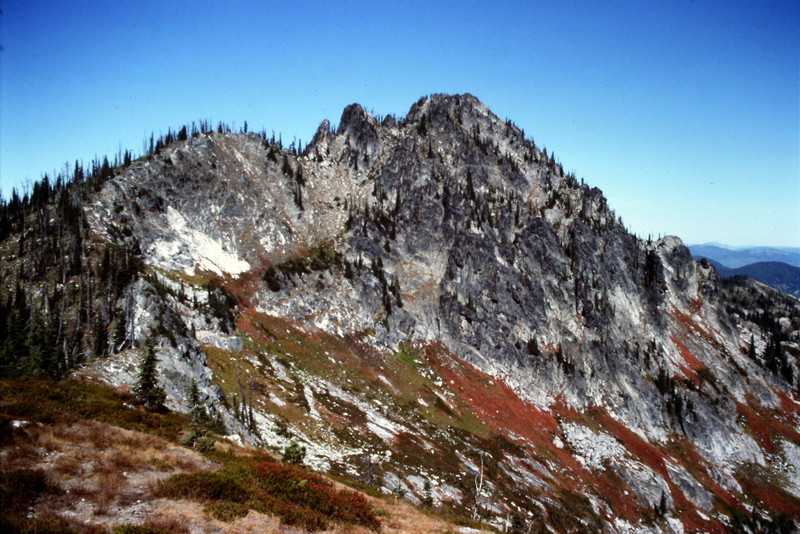
While not ever peak in this area is spectacular, peaks like Chimney Peak are among the state’s finest summits.
The mountain was named after Frank Fenn, the first supervisor of the Clearwater National Forest. Fenn had an illustrious career before taking up public forest management in 1901. A student at Idaho’s first public school at Florence, he later was a cadet at the U.S. Naval Academy and a participant in the Nez Perce Indian War of 1877. He served as Speaker of the House in the first Idaho Legislature and was a major in the U.S. Army during the Spanish-American War. He retired from the Forest Service in 1920 and moved to Kooskia, where he died in 1927.
On the second morning, we started climbing toward the peak, which for all intents and purposes was terra incognita, as there were no guidebooks or internet entries to consult. We climbed up a boulder field to a grass-filled gully on the east side of the third summit. At the top of the gully, we headed north across another boulder field that ledback to the ridgetop. Our progress was then blocked by a rock fin that sat squarely on the ridge. As a rule, when faced with an option to go up or go down, the answer is to go down and around. We followed this maxim and soon found ourselves on the west side of the fin. We then crossed back to the west side of the ridge to bypass the next granite fin. Finally, we crossed the ridge again and found ourselves at the base of the summit block. After all these route-finding difficulties, the final slope was a straightforward, easy scramble to the top. The views were rewarding, as we surveyed huge swaths of the Selway Bitterroot Wilderness. Sitting there, it dawned on us that we still had a long way to get back to the trailhead and home—but that’s another story. Rank: 16.
Big Baldy, Salmon River Mountains
Dana and I finished work and made a long, time-consuming drive to a middle-of-nowhere trailhead north-northeast of Cascade. It was Friday, July 19, 1991. Once we reached the end of the road, we hoisted our packs and started hiking. Our plan was to get as many of the sixteen miles between the trailhead and the lookout as we could before dark and make a dry camp.
Our objective was Big Baldly, a little-known landmark in the massive Salmon River Mountains, named for the Salmon River, which encircles nearly the entire range. The river forms the range’s boundary from Riggins in the northwest to Salmon in the northeast to Challis in the southeast and, finally, to Stanley, halfway across the range’s southern boundary. Big Baldy is located well inside the Frank Church–River of No Return Wilderness, west of the famous Middle Fork Salmon River. The peak has served as a fire lookout since 1923.
A ride walk from the west is the easiest way to reach the peak, but it’s still not easy. It is, however, a classic way to experience The Frank. Rather than traveling along the range’s many rivers, you follow a massive ridge system whose size dwarfs puny humans. The plan I had made indicated that a trip to the summit and back would cover thirty-two miles, and the rollercoaster of a ridgeline would involve little flat hiking. In fact, the journey ended up requiring almost nine thousand feet of elevation gain. That’s a lot of uphill walking with a pack.
As the sky grew dark, we found a flat spot on the ridgetop and camped. The next morning we continued east along the ridge trail to the junction for beautiful Buck Lake. We dropped down to the lake, pitched our tent, filled our water bottles and then continued on to the summit, still a long way off. The ridgeline, like many in these mountains, was interspersed with forest and meadow and provided us with occasional sweeping views. Once we reached the top, the 360-degree view validated both our desire to visit the peak and the Forest Service’s wisdom in placing a lookout on this remote summit. Our mission accomplished, we returned to Buck Lake and enjoyed a restful afternoon. When Sunday came, it was time to head back to the 20th Century, to work and all the other distractions that made even this rushed hiking trip into Idaho’s backcountry invaluable. Rank: 6.
Freeman Peak, Beaverhead Mountains
The first place I lived permanently in Idaho was Salmon. If you’ve visited Salmon, your eyes, like mine, no doubt were drawn to Freeman Peak, perhaps the most beautiful peak in the Beaverhead Mountains.
Locals have been climbing majestic Freeman Peak forever, as demonstrated by an article published in the Idaho Statesman on October 8, 1903, entitled, “Went to the Top of Freeman’s Peak.” The article’s wordy subtitle actually summed up the text well: “Awe-Inspiring Panorama Spread Before the Vision of the Venturesome Climbers—Interesting Description of the Journey—Some Women Who Have Made It.” Those local women were identified as Mrs. Collins and her sister, Miss Mary McNab, Mrs. Clayton, Mrs. Ketctum, and Mrs. Timothy Dore.
The Beaverhead Mountains form the Idaho/Montana border and the Continental Divide for nearly two hundred miles, from Chief Joseph Pass and MT-43 (north of Salmon) to MonidaPass and I-15 (north of Dubois). The Beaverhead crest is graced with pristine glacial cirques, massive limestone cliffs, knife-edged ridges, and dozens of imposing summits. The entire length of the crest is above eight thousand feet, highlighted by two rugged segments: the northern section runs from Lost Trail Pass north of Salmon to Italian Peak, and the southern part runs from Italian Peak eastward to Monida Pass.
On September 3, 1994, Dana and I began our climb from Freeman Creek. Despite my guidebook research, which had turned up a lot of less-than-detailed route information, we didn’t really know where we were going. Of course, not knowing the details of a climbing route is one of the elements that makes climbing such a challenging and enjoyable endeavor. Buoyed by oursense of wonder, we hiked up a rugged 4WD road past the long-abandoned Ore Cash Mine to the base of a steep slope that stretched upwards toward an impressive cirque carved out of the peak’s east face.
Exploring the cirque, we eventually found a steep gully, which we climbed up through the cirque’s walls to the top of the southeastern ridge. When we scrambled up this steep ridge, iteventually brought us to the summit. Stretching below us was the view that Mrs. Collins and her sister, Miss Mary McNab, Mrs. Clayton, Mrs. Ketctum, and Mrs. Timothy Dore had marveled atninety-one years earlier. Rank: 7.
My Twenty-Five Favorite Climbs
1. Bell Mountain Lemhi Range
2. USGS Peak Lost River Range
3. Mount Idaho Lost River Range
4. Mount Heyburn Sawtooth Range
5. Diamond Peak Lemhi Range
6. Big Baldy Peak Salmon River Mountains
7. Freeman Peak Beaverhead Mountains
8. Mount Regan Sawtooth Range
9. Old Hyndman Peak Pioneer Mountains
10. Mount Borah Lost River Range
11. Peak 11272 (Mount Andrus) White Cloud Mountains
12. Mount Corruption Lost River Range
13. Sacajawea Lost River Range
14. Triple Peak Lost River Range
15. Peak 10405 White Cloud Mountains
16. Fenn Mountain Clearwater Mountains
17. Scotchman Peak Cabinet Mountains
18. Chimney Rock Selkirk Mountains
19. Sunny Bar Peak Lemhi Range
20. Umpleby PeakLemhi Range
21. Tower of Babel Seven Devils Mountains
22. Cabin Creek Peak Salmon River Mountains
23. Iron Mountain 9694 Soldier Mountains
24. Devils Throne Seven Devil Mountains
25. Mount Heinen Boise Mountains
Favorite Climbs Part Two
ARTICLE INDEX
